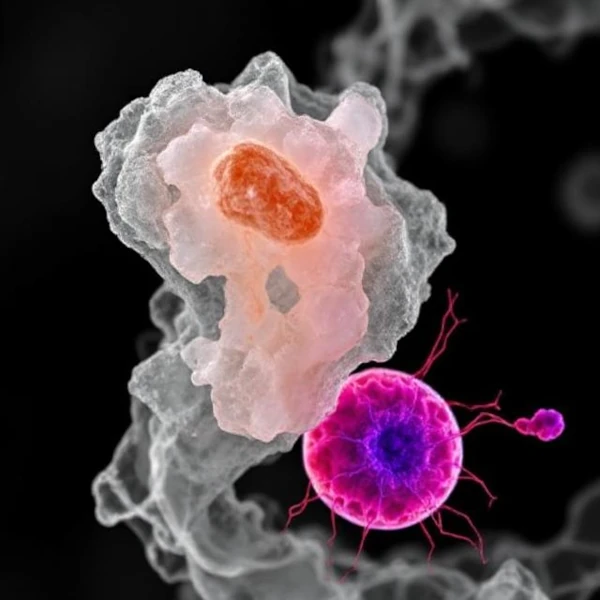
Life is not a trivial property of matter. It does not emerge abruptly but seems to appear at the end of a progressive complexification of chemical structures. If a living cell is unambiguously a living system, what about viruses, prions, or certain self-organized crystals that mimic biological growth? The origin of life lies in a gray area, between chemistry and biology, thermodynamics and information.
A living being must exhibit a number of fundamental characteristics, such as the ability to metabolize energy, to reproduce, to react to its environment, and to evolve. However, these criteria remain ambiguous at the boundary of life. A virus, for example, does not have its own metabolism but can, once inside a host cell, reproduce and evolve. Conversely, a crystal can grow and replicate without ever being alive.
Life is a local negation of entropy. It creates order from the surrounding disorder by exporting entropy outward. This dynamic relies on a highly improbable chemical structure: macromolecules capable of self-replication. Without this property, no self-organized system can claim the status of being alive.
| Entity | Reproduction | Metabolism | Organization | Status |
|---|---|---|---|---|
| Self-replicating Crystals | Yes (under certain conditions) | No | Periodic Order | Inert |
| Prion | Yes (protein conversion) | No | Pathogenic Protein | Non-living |
| Coacervate | No | No | Colloidal Microcompartment | Precursor to Life |
| Prebiotic Life (self-organized chemical systems) | Partially (chemical cycles) | Partially (proto-metabolism) | Dynamic Organization Out of Equilibrium | Boundary of Life |
| RNA World | Yes (self-replication) | Yes (catalytic ribozymes) | Network of Catalytic RNA | Proto-living |
| Virus | Yes (in host cell) | No | Organized Protein Structure | Boundary |
| Living Cell | Yes | Yes | Complex, Compartmentalized | Living |
Modern hypotheses, such as that of prebiotic life or the RNA world, postulate the existence of intermediate systems: neither truly living nor totally inert. These systems may have possessed a rudimentary capacity for self-replication, evolution, or even catalysis, paving the way for a phase transition to the living cell.
One of the most fundamental characteristics of life is its ability to store, process, and transmit information. DNA, often compared to a code, is a molecule but also a vector of instructions. This duality between physical support (nitrogenous base, phosphate, sugar) and informational content (coding sequences, regulations) is unique to biology and absent in inert matter.
Life is based on an algorithmic logic: transcription, translation, feedback, intracellular signaling. These operations not only transform energy or matter but also manage the continuity of an evolutionary program. Even viruses, although on the boundary of life, use genetic information as a vector for replication and evolution.
Life could thus be defined as informed matter capable of self-maintenance and self-replication with variation. Unlike a crystal, whose order is static and without memory, a living cell possesses a genome that encodes functions, which can mutate, be corrected, or selected. This informational approach to life links biology, thermodynamics, and computational theory.
In this sense, the appearance of life on Earth marks a critical transition: that from blind chemistry to chemistry endowed with evolutionary memory. Life is therefore not just matter that reacts but matter that projects itself into the future while preserving the past.
Life would not be a binary property but a progressive emergence, governed by critical thresholds of complexity, stability, and information processing. Understanding this transition means understanding how blind chemistry could generate an entity capable of recognizing itself as alive.
One might think that as a physicochemical phenomenon, life should emerge at a clearly identifiable threshold of molecular complexity. However, this boundary remains elusive. Life does not emerge through the abrupt addition of a "magic molecule" but through a progressive transition where auto-organization, catalytic reactions, compartmentalization, and information processing intertwine.
This absence of a clear threshold is explained by the continuous nature of chemical auto-organization processes. In a universe governed by thermodynamics and the laws of complexity, certain structures can temporarily self-maintain without being capable of Darwinian evolution. Life is therefore an emergent property, not of a single compound, but of a network of functions: replication, variation, selection.
This ambiguity explains why definitions of life vary across disciplines: a biologist will emphasize reproduction, a chemist will focus on autocatalysis, a physicist on non-equilibrium dynamics, and a computer scientist on the ability to process and transmit information. The boundary is therefore not a line but a transition zone, a space of complexity where matter begins to act on itself.
On Earth, life has manifested in conditions once thought incompatible with its existence: high-pressure hydrothermal vents, acidic lakes, deep rocks several kilometers below the surface, hyper-arid deserts, and even natural nuclear reactors like Oklo. These extremophiles defy our former habitability criteria and considerably broaden the spectrum of potentially habitable environments.
This resilience suggests that life is not a fragile accident but a robust phenomenon, capable of adapting to extreme chemical and thermal gradients, provided a source of energy and complex molecules are available. Statistically, if life emerged rapidly on Earth (in less than a billion years), this reinforces the idea that it could appear elsewhere as soon as minimal conditions are met.
However, the universality of life remains a hypothesis. Exoplanets identified as "habitable" have yet to provide any evidence of biosignatures. It is possible that the emergence of life requires a highly improbable conjunction of factors, as suggested by some anthropic models. Thus, the tenacity of life on Earth constitutes a strong indication, but not yet direct proof of its cosmic generality.